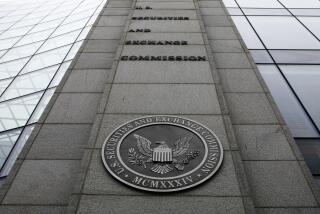Stakes Are High for Stock Markets
- Share via
NEW YORK — The New York Stock Exchange can’t seem to catch a break.
It won a key battle this month when the Securities and Exchange Commission moved to preserve a stock-trading rule that has been crucial to the Big Board’s success.
But there wasn’t any celebrating because the SEC also proposed a change that could make it easier for the NYSE’s electronic trading rivals to snare its customers.
There’s a lot at stake as regulators consider the biggest revamping of stock-trading rules in three decades, and not just for the 212-year-old NYSE and its old-fashioned reliance on human floor brokers to trade stocks. What the SEC decides will have far-reaching implications for investors and the nation’s stock markets.
“It’s extremely dramatic,” said George Rodriguez, managing director of Algorithm Trading Solutions, an institutional brokerage firm in Newark, N.J. “It is one of those events in history that changes the landscape.”
Although the proposals most threaten the NYSE, they could also cause the Nasdaq Stock Market to lose some business. Investors, however, probably would be winners.
The basic issue is whether markets should execute stock trades at the best price available or at the fastest speed, even if at a slightly inferior price. The SEC has long required that NYSE trades be at the best price -- meaning the highest for sellers and lowest for buyers.
Nasdaq, an electronic-based market established in 1971, has never been required to abide by the best-price rule but would be forced to do so under the SEC proposals.
The best-price rule is also known as the “trade-through” rule because it bars investors from trading through, or bypassing, a better price. That helps small investors who can’t protect themselves against brokers or others who could benefit from giving them inferior prices.
The rule has been a boon to the NYSE. Because the Big Board often lists the best price, other markets sometimes have to send orders there -- an upper hand the NYSE wants to keep.
For years, Nasdaq and a host of upstart electronic trading networks have argued that the trade-through rule should be eliminated because it limits their ability to trade NYSE stocks. The NYSE controls trading in about 80% of the stocks listed on its exchange, a far higher market share than Nasdaq has for its stocks.
Rivals say institutions such as mutual funds want fast trades, and argue that the Big Board uses the rule to shield itself from competition.
The SEC sided with NYSE rivals in February when it floated a proposal that would allow investors, in some situations, to opt for speed over best price, thus potentially circumventing the NYSE. But the staff reversed course this month when it proposed expanding the trade-through rule to other markets, the biggest being Nasdaq.
The five-member commission is expected to vote on the plan early in 2005, after a public comment period. Two commissioners, however, raised concerns about the proposal, and it’s unclear whether the staff proposal will survive as currently drafted.
The staff also gave the commission two alternatives for updating the current stock-trading system.
The first proposal largely preserves existing rules in which markets display only the single best bid or offer for any stock.
The second would create incentives for markets to display all their orders for a given stock, and would allow investors to quickly grab those orders. That’s a big deal for the NYSE, because this information is now available only to the floor brokers and specialist firms who handle stock trades.
These brokers use their privileged access to the “book” of orders to make their own trades, so forcing them to share the book with investors might be compared to forcing a blackjack dealer to divulge his hole card at the beginning of a hand.
Knowing that a stock has a backlog of “buy” orders, for example, could signal a coming rise in a stock’s price and prompt a broker or specialist to load up on shares. Taking away access to that information could make it much tougher for brokers and specialists to make money, experts say.
“If the SEC goes all the way, it’s going to make it much more difficult for the NYSE to stay in business,” said Junius Peake, a finance professor at the University of Northern Colorado.
In a recent conference call with reporters, John A. Thain, NYSE chief executive, acknowledged that the proposal threatens the NYSE’s auction-style market in which humans gather on the famed trading floor to swap shares. It also could disrupt the exchange’s incipient plans for a “hybrid” market that would meld increased electronic trading into its system, he said.
Thain said the SEC plan to expose the order book would result in a generic electronic system that stymies innovation because markets would no longer compete for business.
“The biggest negative from investors’ point of view is the elimination of competition between the marketplaces,” he said.
The overall effect of the proposed changes, experts say, could be more orders going to electronic rivals. But anything that drains the NYSE’s market share could be a blow.
That’s partly because of the way stock markets work. Investors go where there are other investors because they want the best chance to find people willing to trade with them at reasonable prices.
In other words, trading volume itself draws more trading volume.
“The more orders they have to work on that floor, the more valuable that floor is,” said James Angel, an associate finance professor at Georgetown University. “And if you peel away bits and pieces of those orders, then the floor becomes less valuable.”
For Nasdaq, the SEC proposals could yield mixed results.
The market could gain if it becomes easier for it to trade NYSE stocks. On the other hand, the extension of the trade-through rule to Nasdaq would force it to send some orders in its own stocks to smaller electronic markets with superior prices.
Frank Hatheway, Nasdaq chief economist, contends the rule isn’t needed, saying “the great majority of people who trade on Nasdaq want the best price and get the best price.”
More to Read
Inside the business of entertainment
The Wide Shot brings you news, analysis and insights on everything from streaming wars to production — and what it all means for the future.
You may occasionally receive promotional content from the Los Angeles Times.










